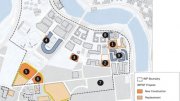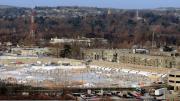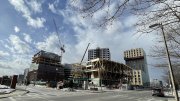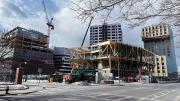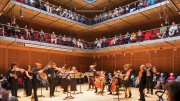A quarter-century after the University first acquired land in Allston, in 1989, to accommodate growth, it may begin construction of the first academic facility there. At the Faculty of Arts and Sciences meeting on February 5 (as this magazine went to press; Read a more in-depth analysis on the University’s expanding campus here), President Drew Faust told the gathered professors that planning “has evolved” for the ultimate use of an Allston science complex on which construction was suspended (given financial constraints) in 2010. What was outlined last summer as a health- and life-sciences facility (where stem-cell researchers and others would be relocated) has now been reenvisioned as “an anchoring presence” for “the substantial majority of SEAS” (the School of Engineering and Applied Sciences), plus flexible laboratory space to accommodate other researchers. Faust described the decision as an “extraordinary opportunity” for Harvard and for SEAS to accommodate growth; build facilities for collaborative, interdisciplinary research; and create innovative spaces to support those priorities. The school “must grow” she said, and could, in its new home, become “a hub in a wheel of connectivity” shaping the rest of the developing Allston site.
Provost Alan Garber, who directs scientific programming for the facility, noted that planning for this first major Allston academic building was only that: subsequent phases of development would enlarge the academic presence in the area over time. The contemplated move, he said, was four to five years in the future. (In January, Harvard announced that architect Stefan Behnisch had been retained to work on the science center; he designed the original complex on which work was halted, and now faces the task of adapting his prior work to different users and likely a more stringent budget—with University officials suggesting construction could begin in 2014.) Between now and the time for occupancy, Garber said, there would be “lots to learn” about improving transportation; resolving the challenges of scheduling courses to accommodate students whose other work is in Cambridge; and maintaining research collaborations. The first round of solutions, he acknowledged, might not be “perfect.” He reiterated that a major motivation for contemplating moving “the majority of SEAS” (without specifying what parts might not relocate) is that “SEAS needs to grow.” That reflects both the present scientific momentum and the judgment of the school’s visiting committee and of alumni active in the field.
Although the prospect of brand-new facilities; proximity to the entrepreneurs across Western Avenue at Harvard Business School (HBS) and the Harvard Innovation Lab; and the potential to fulfill SEAS’s long ambition to expand with at least a few dozen new professorships may ultimately prove compelling, the faculty speakers who rose to comment conveyed deep concern and even sharp reservations about the plan. Michael D. Mitzenmacher, McKay professor of computer science and area dean for computer science, said the faculty had learned of the plan only a week earlier, when Garber briefed them. Citing relocation away from students and scientific colleagues, he said, “Isolating us has the potential to defeat both our educational and our research purposes.” Although he and many colleagues wished to feel enthusiastic about the proposal, as presented—without solutions to the challenges moving might pose—it felt like “the cart before the horse.” He called for “more openness, more clarity, and more answers to our important questions” about logistics, what else might be developed in Allston and when, and what SEAS might gain in resources and personnel. Steven Wofsy, Rotch professor of atmospheric and environmental science and area dean for environmental science and engineering, said of his field’s networked research and teaching, “If we move, our paradigm can’t work.”
A period of intensive consultation is about to begin. SEAS has been on a sharp growth trajectory since becoming a school in 2007, but is out of space. Student enrollment is burgeoning. Society’s interest in engineering and applied sciences is robust. There are natural affinities between SEAS and HBS’s work. A major capital campaign is quietly under way. Whatever the initial fireworks, after many ambitious plans laid low by financial and other constraints, Allston’s academic development is in the offing.
